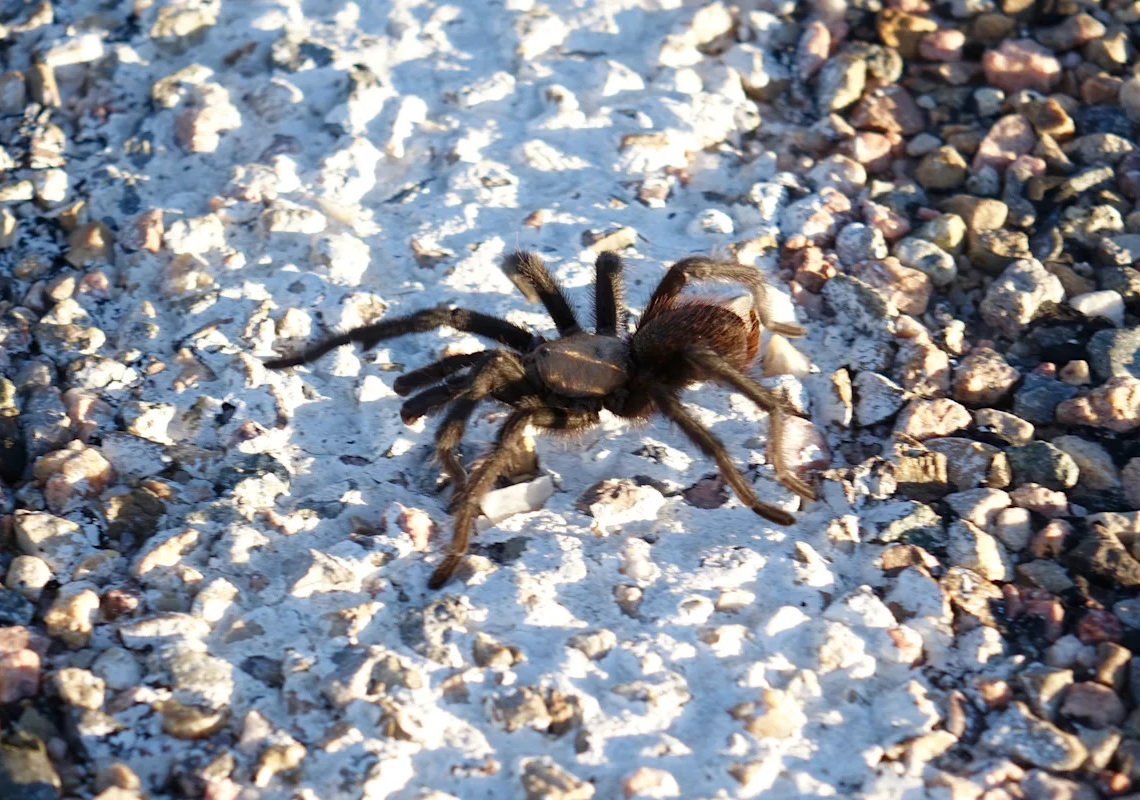If you’re hiking or camping in the arid Southwest and West in the next few months, get ready for what could be the experience – or fright – of a lifetime.
Across the United States, in California, Colorado, Kansas, New Mexico and Texas, tens of thousands of tarantulas will being crawling out of their burrows in search of females – making for a fascinating, if a little creepy – display of the wonders of nature.
It’s tarantula mating season.
“If you’re lucky enough you can sometimes see them in hordes crossing the roads at certain times of the year,” said Dan McCamish, a senior environmental scientist with California State Parks.
His advice? Leave them alone.
“It’s a wild animal – it doesn’t want to be picked up and loved and hugged,” he said. “In general the species is very docile, but if you were to handle one they could bite you.”
While the idea of thousands of hairy, baseball-sized spiders picking their way through parks and campgrounds might give many people the heebie-jeebies, in general these misunderstood, wandering arachnids are simply young males in search of love.
And if they wander into your tent, they didn’t mean to.
“In truth they’re gentle, ecologically valuable animals,” said McCamish. “Mostly they’re interested in escaping from confrontations – especially with something they know could squish them.”
Here’s what to know about tarantulas during their mating season.
Where in the US do tarantulas live?
Tarantulas prefer dry climates and primarily live in Western and Southwestern states with arid and semi-arid habitats. They are prevalent in Arizona, California, Texas, New Mexico, Nevada, Utah, Colorado, Oregon and Washington.
But they’re in other places as well. South Florida has the Mexican red rump and the Texas brown can be found in Oklahoma and Missouri.
There are 29 described individual species of tarantulas in the United States.
Common species include the desert blonde tarantula and the Texas brown (though Texas has 14 tarantula species). In Arizona, there’s even a variety with a fiery-red abdomen.
When are you likely to see tarantulas in the wild?
Tarantulas live in these areas year-round, but they mostly keep to themselves and their nests in the ground, so hikers and campers don’t see a lot of them.
“As with most things that live in the desert in the summer, they’re generally nocturnal,” McCamish said. “So unless you’re out in the middle of the night, which I don’t recommend for safety purposes, you likely won’t see them.”
Then in fall, September, October, November, the weather starts to shift. “They generally wait for the first fall seasonal rain – they really respond to the late summer warmth and the increase in moisture,” he said.
“They’re typically out from late evening into early dawn,” he said. “That’s when visitors tend to see them,” said McCamish.
“The males are the ones you’ll see crawling around. If you come upon a tarantula out in the wild and it’s wandering about, it’s likely a male. If you come upon one that’s sitting in its burrow or on top of a hole, it’s likely a female waiting for males to mate with,” he said.
Why don’t we see tarantulas at other times of the year?
Both males and females retreat to their burrows in the winter, where they enter a kind of torpor that isn’t true hibernation. In the spring they begin hunting again, though not far from their shelters.
The arachnids build webs nears their burrows where they capture insects, beetles, grasshoppers and smaller spiders for food.
“They’re ambush hunters. The females weave a web around the hole to their burrow that’s sensitive to the touch. If an insect comes across it, the spider pounces and kills it with their fangs,” he said.
The males also go out to hunt on foot. However, this tends to happen late at night when the desert comes alive – and humans aren’t typically out, which is why most desert visitors never see them.
The short, harsh reality of a male tarantula’s life
Male and female tarantulas live very different lives. Females stay near their burrows, hunting, feeding and growing and can live for up to 20 to 25 years.
Males, not so much.
Once they’re hatched, they create burrows and spend a few years, generally no more than five, slowly growing, molting several times as they do.
When they are ready to go out to find a mate in the cool fall, they leave their burrows and begin wandering, sniffing the air for female pheromones.
The females come out of their burrows at night, staying nearby as they wait for the males.
If the male finds a female, and she accepts him, they will mate. But it’s a brief moment of happiness for the male.
“The harsh reality is that generally after the male breeds, it passes away,” McCamish said.
Often, the female will eat her mate, though not always. It depends on whether she fed before mating or has an ample food supply.
If the male doesn’t find a mate, it can potentially burrow back in for another year, but this depends on its molting schedule – if the male spider needs to molt again after it becomes sexually viable, it may die because it cannot molt a second time.
“Generally, once the male has emerged, if it is unsuccessful in finding a mate during the season, it will likely die due to exhaustion,” he said.
Here’s why you shouldn’t kill tarantulas
If you see a tarantula, leave it alone. It plays an important part in nature. These large, hairy spiders contribute to ecological balance, acting as insect control – they are slow, patient ambush predators that regulate biodiversity.
Their burrows improve soil aeration and water filtration, especially in the desert during flooding events. And after they abandon their burrows, they become refuges for other animals including lizards, insects and other small mammals, McCamish said.
They’re also an excellent midlevel ecological stabilizer that tells biologists at a glance if an ecosystem is healthy.
“If there are tarantulas living somewhere, you can generally assume the habitat is functioning,” McCamish said.
What eats tarantulas?
Tarantulas may look terrifying as they make their leggy way across the landscape, but they’re nowhere near the top of the food chain.
They can be food for foxes, coyotes, snakes, owls and skunks – one reason they lay low except when the mating imperative sends them out into a dangerous world.
There’s also a rather gruesome fate that can await them – an encounter with a tarantula hawk wasp.
These are large wasps, an inch or two long, that have bright orange wings and sound like a Cessna airplane engine if they fly by your ear, said McCamish.
“Their sting has been compared to … the second or third worst sting of any insect in the world,” he said.
The sting isn’t the worst of it for tarantulas.
“They land on their back and then bite the tarantula to paralyze it. Then they lay their eggs inside it, turning the spider’s body into a living food source once the larva hatch,” McCamish said.
Are tarantulas dangerous?
Tarantulas don’t want to interact with humans any more than most humans want to interact with them.
“No native tarantulas in the United States pose a serious threat to humans,” McCamish said. The only caveat is if someone has had serious reactions to spider bites in the past.
In reality, the danger only comes when people try to pick them up or play with them, or if they get in the way of a male and female mating.
Because they’re naturally timid, observing them from a few feet away is fine. “If it starts coming towards you, give it some space. It might be defending its eggs, or you might have interrupted a mating ritual between a male and female,” he said.
Touching a tarantula can be painful because they have tiny barbed hairs on their abdomen called urticating hairs.
“They can actually flick those hairs off their back feet like darts,” he said. If they get on your skin – or worse your eye if you picked it up to look more closely – it could cause irritation.
How do you convince a tarantula to go away?
During mating season, it’s not uncommon for a tarantula to wander into campsites or tents, McCamish said.
To gently and safely encourage it to be on its way, the best method is to find a stick and give it a “light tickle” on its abdomen to get it to move away.
“Just give it a light boop on the base of its abdomen and generally they’ll move in that direction,” he said.
If the tarantula has come into contact with your clothing, bedding or a pillow, it’s not a bad idea to wipe it down or even take duct tape and dab it on the surface to remove any of the irritating hairs that might have stuck.
Tarantulas can jump as much as two feet
There is one thing to be aware of – these spiders can jump as much as a foot or two, and they can get into trees.
“They’re ambush predators, after all,” McCamish said. “Just because they’re ground dwelling creatures that doesn’t mean they don’t climb bushes or trees.”
This story was updated to add map showing tarantula range in United States.
This article originally appeared on USA TODAY: Tarantula mating season is coming. Brace for ‘hordes’ of them.
The post Watch out for ‘hordes’ of tarantulas coming soon to these states appeared first on USA TODAY.



